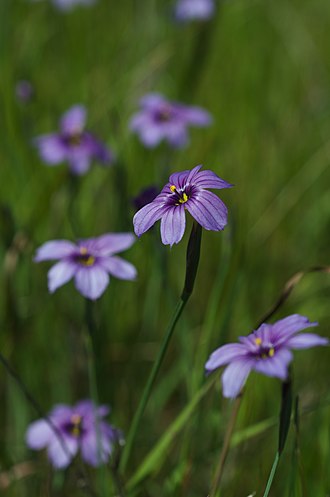
Native to moist grassy areas and woodlands of California and Oregon west of the Sierra Nevada, this semi-evergreen herbaceous perennial is not a true grass but is in the iris family, Iridaceae, that also includes crocus, gladiolus, and freesia. The plants grow up to 2′ tall and forms sparse tufts of sword-shaped, blue-green leaves that are 8-10″ long. From early spring to summer, flattened, branched, winged stems produce loose clusters of flowers well above the foliage. The flowers are 3/4-1″ across and have a yellow center and 6 tepals that are blue to violet-blue, occasionally white. Although each flower only lasts one day, they are produced in abundance. The dark brown fruits contain a very large amount of seed so that the plants tend to spread in the garden. After blooming the plants die back and go dormant for the summer. The plants look best when planted in large groups and are especially valued for use in informal gardens such as meadows, prairies, or cottage gardens. The genus name, Sisyrinchium, may come from the from the Greek sys-, meaning pig, and rynchos , meaning snout, referring to the roots being consumed by swine. The specific epithet, bellum, is the contraction of the Latin word belulus and means pretty.
Type: Semi-evergreen herbaceous perennial
Bloom: Clusters of blue to violet blue flowers with yellow centers from early spring to summer
Size: 3″-2′ H x 4″-2’W
Light: Full sun to partial shade
Soil: Average, moist to wet, well-drained; somewhat drought tolerant once established
Hardiness: Zones 7-8
Care: Remove plant debris in summer
Pests and Diseases: None of significance
Propagation: Seed, division of rhizomes, cuttings of flowering stems
Companion Plants: California poppy, California buckwheat, prairie smoke
Outstanding Selections: None available
Photo Credit: Wikipedia